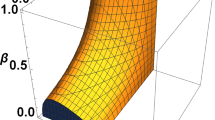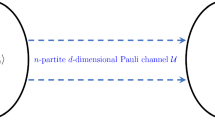Abstract
The resource theory of imaginarity provides a valuable framework for understanding the role of complex numbers. Quantum channels play a vital role in extraction and transmission of information, and they can both destroy and create imaginarity in quantum states. In this article, we introduce the concepts of imaginaring and deimaginaring power of quantum channels to describe quantum channels’ ability to create and destroy imaginarity. Furthermore, the imaginaring and deimaginaring power for several typical single-qubit channels based on \(l_{1}\) norm, robustness and relative entropy of imaginarity were computed. In addition, we define the non-imaginarity-generating channel as the completely positive trace-preserving map which does not generate quantum imaginarity from an real state. Several properties of non-imaginarity-generating channels are investigated. Finally, we explore the trade-off relationship between imaginarity and entanglement. The relationship between the deimaginaring power of quantum channels based on relative entropy of the imaginarity and entanglement is studied. Additionally, we explore the creation of imaginarity in a bipartite state. We demonstrate that it is dependent on both the mixedness of initial system and the minimum amount of entanglement that can be created. Our work further studies imaginarity, which will contribute to the development of quantum mechanics and quantum techniques.




Similar content being viewed by others
Data Availability
Data sharing not applicable to this article as no datasets were generated or analyzed during the current study.
References
Wootters, W.K.: Entanglement sharing in real-vector-space quantum theory. Found. Phys. 42, 19–28 (2012)
Hardy, L., Wootters, W.K.: Limited holism and real-vector-space quantum theory. Found. Phys. 42, 454–473 (2012)
Aleksandrova, A., Borish, V., Wootters, W.K.: Real-vector-space quantum theory with a universal quantum bit. Phys. Rev. A 87, 052106 (2013)
Hickey, A., Gour, G.: Quantifying the imaginarity of quantum mechanics. J. Phys. A: Math. Theor. 51, 414009 (2018)
Wu, K., et al.: Operational resource theory of imaginarity. Phys. Rev. Lett. 126, 090401 (2021)
Wu, K., et al.: Resource theory of imaginarity: quantification and state conversion. Phys. Rev. A 103, 032401 (2021)
Wu, K., et al.: Resource theory of imaginarity: New distributed scenarios (2023). arXiv preprint arXiv:2301.04782
Xue, S., Guo, J., Li, P., Ye, M., Li, Y.: Quantification of resource theory of imaginarity. Quantum Inf. Process. 20, 1–20 (2021)
Chen, Q., Gao, T., Yan, F.: Measures of imaginarity and quantum state order (2022). arXiv preprint arXiv:2210.14443
Ollivier, H., Zurek, W.H.: Quantum discord: a measure of the quantumness of correlations. Phys. Rev. Lett. 88, 017901 (2001)
Dakić, B., Vedral, V.: Brukner, Č: Necessary and sufficient condition for nonzero quantum discord. Phys. Rev. Lett. 105, 190502 (2010)
Piani, M.: Problem with geometric discord. Phys. Rev. A 86, 034101 (2012)
Luo, S.: Using measurement-induced disturbance to characterize correlations as classical or quantum. Phys. Rev. A 77, 022301 (2008)
Mišta, L., Jr., Tatham, R., Girolami, D., Korolkova, N., Adesso, G.: Measurement-induced disturbances and nonclassical correlations of Gaussian states. Phys. Rev. A 83, 042325 (2011)
Luo, S., Fu, S.: Measurement-induced nonlocality. Phys. Rev. Lett. 106, 120401 (2011)
Muthuganesan, R., Sankaranarayanan, R.: Fidelity based measurement induced nonlocality. Phys. Lett. A 381, 3028–3032 (2017)
Baumgratz, T., Cramer, M., Plenio, M.B.: Quantifying coherence. Phys. Rev. Lett. 113, 140401 (2014)
Winter, A., Yang, D.: Operational resource theory of coherence. Phys. Rev. Lett. 116, 120404 (2016)
Chitambar, E., Gour, G.: Critical examination of incoherent operations and a physically consistent resource theory of quantum coherence. Phys. Rev. Lett. 117, 030401 (2016)
Streltsov, A., Adesso, G., Plenio, M.B.: Colloquium: quantum coherence as a resource. Rev. Mod. Phys. 89, 041003 (2017)
Mani, A., Karimipour, V.: Cohering and decohering power of quantum channels. Phys. Rev. A 92, 032331 (2015)
Hu, X.: Channels that do not generate coherence. Phys. Rev. A 94, 012326 (2016)
Vedral, V., Plenio, M.B., Rippin, M.A., Knight, P.L.: Quantifying entanglement. Phys. Rev. Lett. 78, 2275 (1997)
Horodecki, R., Horodecki, P., Horodecki, M., Horodecki, K.: Quantum entanglement. Rev. Mod. Phys. 81, 865 (2009)
Eltschka, C., Siewert, J.: Quantifying entanglement resources. J. Phys. A Math. Theor. 47, 424005 (2014)
Bennett, C.H., et al.: Teleporting an unknown quantum state via dual classical and Einstein-Podolsky-Rosen channels. Phys. Rev. Lett. 70, 1895 (1993)
Ekert, A.K.: Quantum cryptography based on bell’s theorem. Phys. Rev. Lett. 67, 661 (1991)
Bennett, C.H., Brassard, G., Mermin, N.D.: Quantum cryptography without bell’s theorem. Phys. Rev. Lett. 68, 557 (1992)
Slutsky, B.A., Rao, R., Sun, P.-C., Fainman, Y.: Security of quantum cryptography against individual attacks. Phys. Rev. A 57, 2383 (1998)
Renes, J.M., Grassl, M.: Generalized decoding, effective channels, and simplified security proofs in quantum key distribution. Phys. Rev. A 74, 022317 (2006)
Masanes, L.: Universally composable privacy amplification from causality constraints. Phys. Rev. Lett. 102, 140501 (2009)
Pawłowski, M.: Security proof for cryptographic protocols based only on the monogamy of bell’s inequality violations. Phys. Rev. A 82, 032313 (2010)
Zhou, Y.-H., Yu, Z.-W., Wang, X.-B.: Making the decoy-state measurement-device-independent quantum key distribution practically useful. Phys. Rev. A 93, 042324 (2016)
Hillery, M., Bužek, V., Berthiaume, A.: Quantum secret sharing. Phys. Rev. A 59, 1829 (1999)
Gao, T., Yan, F., Li, Y.: Quantum secret sharing between m-party and n-party with six states. Sci. China Ser. G 52, 1191–1202 (2009)
Bennett, C.H., Wiesner, S.J.: Communication via one-and two-particle operators on Einstein-Podolsky-Rosen states. Phys. Rev. Lett. 69, 2881 (1992)
Long, G., Liu, X.: Theoretically efficient high-capacity quantum-key-distribution scheme. Phys. Rev. A 65, 032302 (2002)
Yan, F., Zhang, X.: A scheme for secure direct communication using epr pairs and teleportation. Eur. Phys. J. B-Condens. Matter Compl. Syst. 41, 75–78 (2004)
Yu, X.-D., Zhang, D.-J., Xu, G., Tong, D.: Alternative framework for quantifying coherence. Phys. Rev. A 94, 060302 (2016)
Liu, C., Yu, X.-D., Tong, D.: Flag additivity in quantum resource theories. Phys. Rev. A 99, 042322 (2019)
Takagi, R., Regula, B., Bu, K., Liu, Z.-W., Adesso, G.: Operational advantage of quantum resources in subchannel discrimination. Phys. Rev. Lett. 122, 140402 (2019)
Takagi, R., Regula, B.: General resource theories in quantum mechanics and beyond: operational characterization via discrimination tasks. Phys. Rev. X 9, 031053 (2019)
Ducuara, A.F., Skrzypczyk, P.: Operational interpretation of weight-based resource quantifiers in convex quantum resource theories. Phys. Rev. Lett. 125, 110401 (2020)
Uola, R., Bullock, T., Kraft, T., Pellonpää, J.-P., Brunner, N.: All quantum resources provide an advantage in exclusion tasks. Phys. Rev. Lett. 125, 110402 (2020)
Ye, M., Li, Y., Li, Z.: Operational characterization of weight-based resource quantifiers via exclusion tasks in general probabilistic theories. Quantum Inf. Process. 20, 1–28 (2021)
Pourkarimi, M.R.: Time evolution of quantum correlation and entropic uncertainty relation in the presence of quantum memory under noisy channels and one-axis twisting hamiltonian. J. Res. Many-Body Syst. 10, 15–25 (2020)
Nielsen, M.A., Chuang, I.: Quantum computation and quantum information (2002)
Peres, A.: Quantum theory: concepts and methods. Springer, Berlin (1997)
Wilde, M.M.: Quantum information theory. Cambridge University Press (2013)
Wootters, W.K.: Entanglement of formation of an arbitrary state of two qubits. Phys. Rev. Lett. 80, 2245 (1998)
Streltsov, A., Kampermann, H., Bruß, D.: Linking quantum discord to entanglement in a measurement. Phys. Rev. Lett. 106, 160401 (2011)
Horodecki, M., et al.: Local versus nonlocal information in quantum-information theory: formalism and phenomena. Phys. Rev. A 71, 062307 (2005)
Oppenheim, J., Horodecki, M., Horodecki, P., Horodecki, R.: Thermodynamical approach to quantifying quantum correlations. Phys. Rev. Lett. 89, 180402 (2002)
Acknowledgements
This paper was supported by National Science Foundation of China (Grant Nos. 12071271,11671244). Y. Luo was supported by the National Natural Science Foundation of China (Grant No. 62001274)
Author information
Authors and Affiliations
Corresponding author
Ethics declarations
Conflict of interest
The authors declare that they have no conflict of interest.
Additional information
Publisher's Note
Springer Nature remains neutral with regard to jurisdictional claims in published maps and institutional affiliations.
Rights and permissions
Springer Nature or its licensor (e.g. a society or other partner) holds exclusive rights to this article under a publishing agreement with the author(s) or other rightsholder(s); author self-archiving of the accepted manuscript version of this article is solely governed by the terms of such publishing agreement and applicable law.
About this article
Cite this article
Zhang, J., Luo, Y. & Li, Y. Imaginaring and deimaginaring power of quantum channels and the trade-off between imaginarity and entanglement. Quantum Inf Process 22, 405 (2023). https://doi.org/10.1007/s11128-023-04131-w
Received:
Accepted:
Published:
DOI: https://doi.org/10.1007/s11128-023-04131-w




